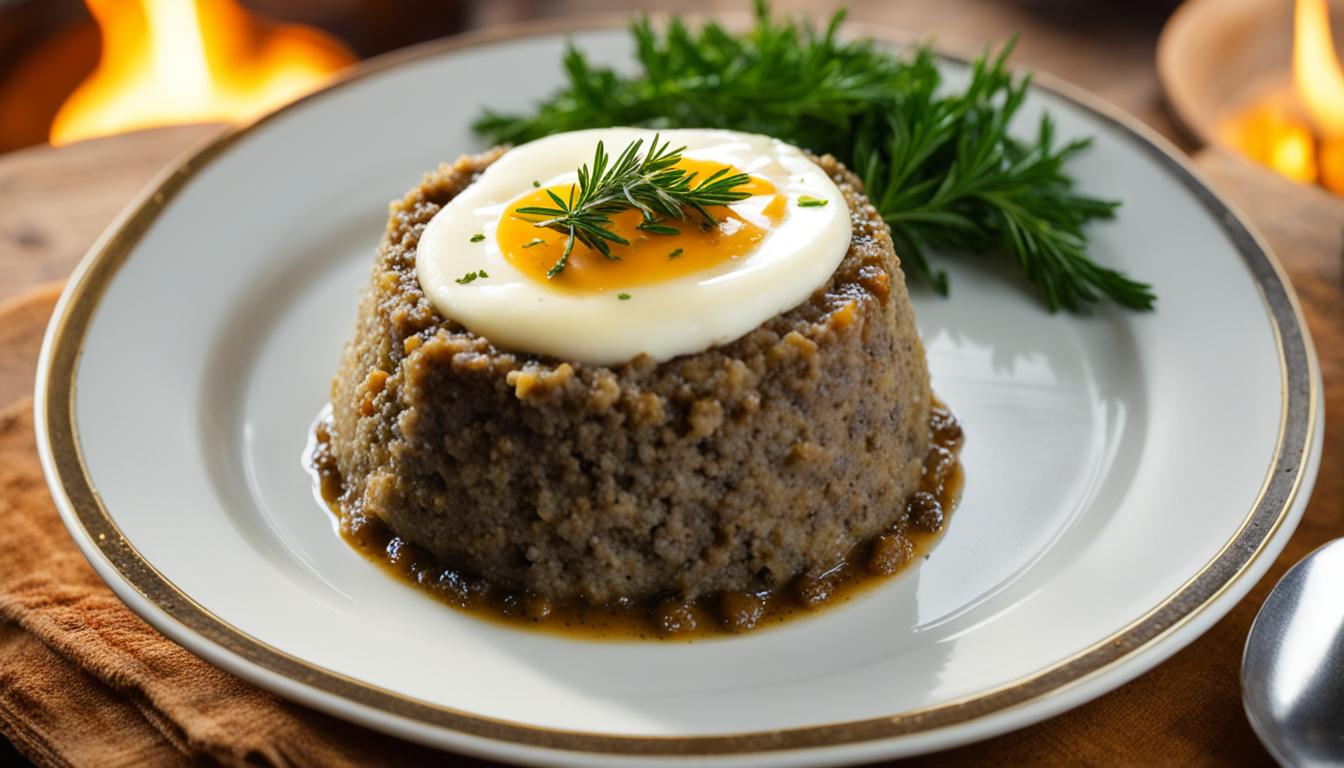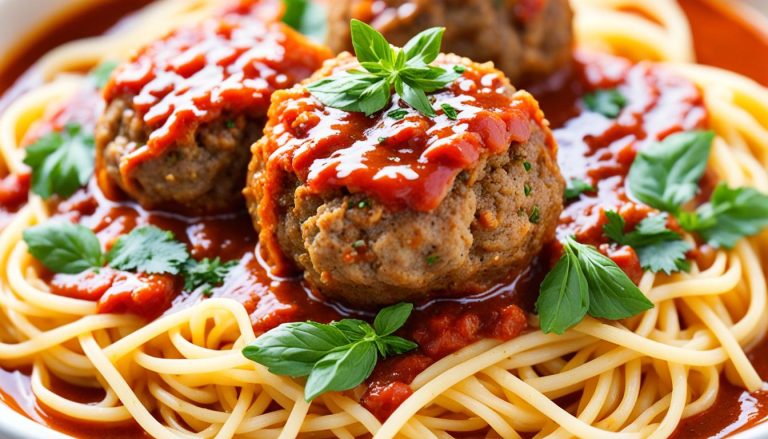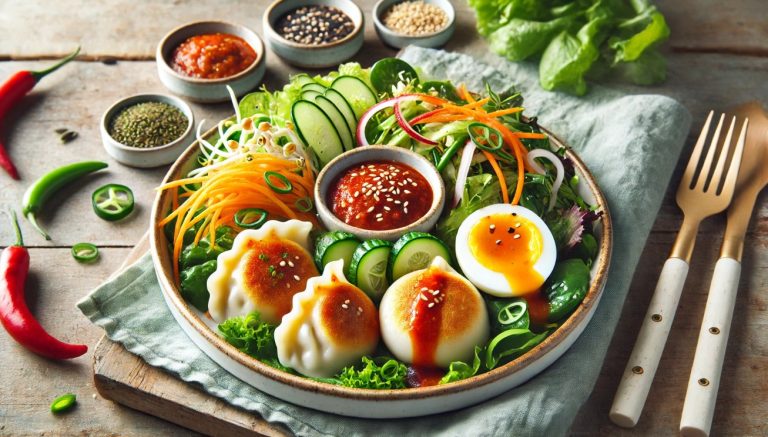Growing up in the rolling hills of Scotland, the aroma of simmering haggis would fill the air, signalling the start of a cherished tradition. As a youngster, I remember the excitement of gathered loved ones, eagerly awaiting the unveiling of this iconic Scottish dish. The ritual of serving the haggis with its accompanying neeps (mashed swede) and tatties (mashed potatoes) was a truly special moment, steeped in the rich culinary heritage of my homeland.
Today, I’m thrilled to share an authentic, step-by-step guide to creating your own delectable Scottish haggis at home. Whether you’re a seasoned enthusiast or newcomer to this savoury pudding, this recipe will transport you to the heart of Scotland, offering a taste of our nation’s cherished traditions. From the history and origins of this iconic dish to the key ingredients and preparation methods, you’ll discover the secrets to crafting a truly exceptional haggis that will delight your senses and warm your soul.
What is Haggis?
Haggis is a traditional Scottish savoury pudding that has become an iconic part of the nation’s culinary heritage. Made from a delectable blend of lamb offal (heart, lungs and liver), coarse oatmeal, onions and a medley of aromatic spices, haggis is typically encased in a sheep’s stomach or synthetic casing. This savoury pudding is considered the national dish of Scotland and has a rich history that can be traced back to Roman or Viking origins.
Traditional Scottish Dish
The distinct flavour and texture of haggis have made it a beloved part of Scottish cuisine, with the dish strongly associated with the annual Burns Night celebration held on 25th January. This event commemorates the life and work of Scotland’s revered national poet, Robert Burns, and the traditional haggis supper is a central component of the festivities.
Savoury Pudding of Lamb Offal and Oatmeal
The combination of lamb offal and coarse oatmeal in haggis creates a rich, hearty and distinctly textured savoury pudding that has become a cornerstone of traditional Scottish cuisine. The offal provides the dish with its characteristic robust, earthy flavour, while the oatmeal lends it a satisfying, almost creamy, consistency.
Origins and History
The origins of haggis can be traced back centuries, with some scholars suggesting Roman or Viking influences on the dish’s development. Regardless of its precise origins, haggis has become deeply woven into the fabric of Scottish culture, representing the nation’s resilience, resourcefulness and unwavering culinary traditions. As a beloved regional British dish, haggis continues to be celebrated and enjoyed by Scots and food enthusiasts around the world.
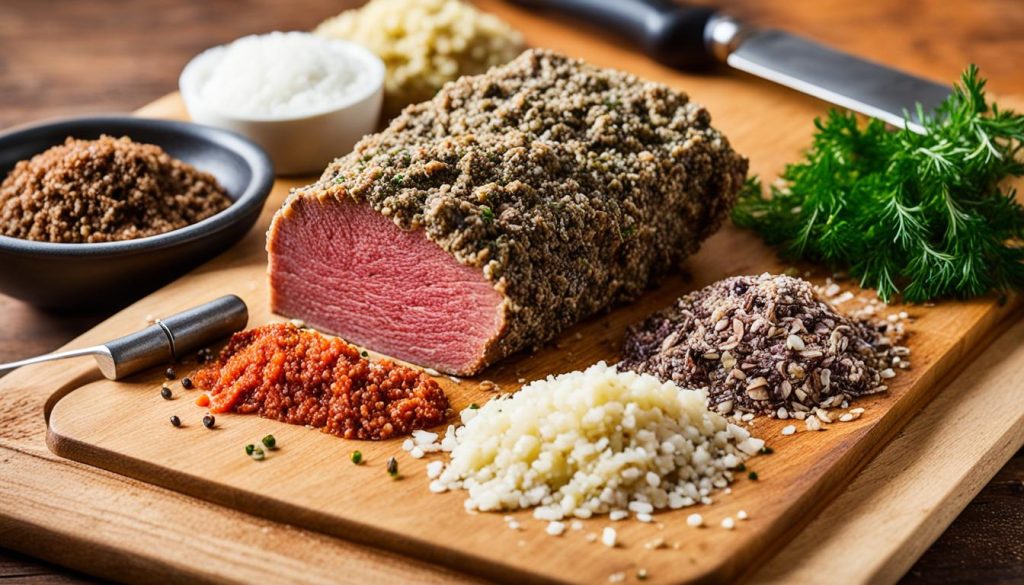
Scottish Haggis Recipe
Haggis Ingredients
At the heart of traditional Scottish haggis are the essential ingredients that come together to create this iconic savoury pudding. From the aromatic lamb pluck to the textural coarse oatmeal, each component plays a vital role in shaping the distinctive flavour and mouthfeel of haggis.
Lamb Pluck (Heart, Lungs and Liver)
The lamb pluck, consisting of the heart, lungs and liver, is the primary source of the rich, meaty essence that defines the character of haggis. This offal mixture provides the dish with its robust and earthy flavour profile, layering in a depth of umami that is essential to the traditional recipe.
Coarse Oatmeal or Pinhead Oats
Providing the haggis with its characteristic texture and substance, coarse oatmeal or pinhead oats are a crucial ingredient. These larger, more granular grains lend a satisfying chew and hearty mouthfeel to the haggis, balancing out the density of the lamb pluck.
Ox Bung Casing
Traditionally, Scottish haggis is encased within an ox bung, the natural casing derived from the large intestine of the ox. This casing not only helps to shape the pudding’s form but also contributes to the overall textural experience, adding a subtle earthy quality to the finished dish.
Spices and Seasoning
A blend of aromatic spices and seasonings is used to complement the robust flavours of the haggis ingredients. Common spices include black pepper, coriander and mace, which work in harmony to enhance the savoury, earthy notes of the lamb pluck and oatmeal.
| Ingredients |
|
1 lamb pluck (heart, lungs, and liver)
|
| 200g coarse oatmeal |
| 100g suet |
|
1 large onion, finely chopped
|
| 1 tsp black pepper |
| 1 tsp ground coriander |
| 1/2 tsp mace |
|
Ox bung casing or pudding basin
|
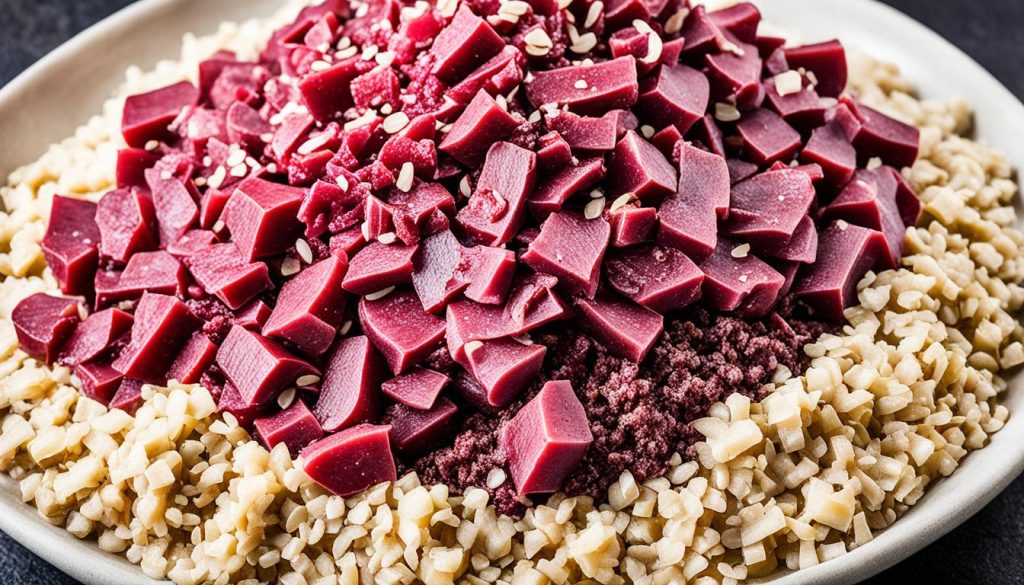
How to Make Haggis?
Making haggis from scratch involves several key steps. First, the lamb pluck (heart, lungs and liver) must be thoroughly cleaned, trimmed and cooked in simmering water for around 2 hours to tenderise the meat. This process of cooking the pluck is an essential part of the haggis preparation.
Preparing the Pluck
The cleaned and trimmed lamb pluck is the foundation of the haggis. This combination of heart, lungs and liver provides the rich, meaty flavour that is so integral to the dish. Simmering the pluck for 2 hours helps to break down the tough tissues, resulting in a tender, succulent texture.
Cooking the Meat
Once the pluck has been cooked to perfection, it is time to dice or grate the meat into small pieces. This ensures an even distribution of the offal throughout the haggis filling. The cooked, prepared pluck is then combined with the coarse oatmeal, suet, spices and seasonings to create the haggis filling.
Mixing the Haggis Filling
The carefully mixed haggis filling is the heart of the dish. The oatmeal provides the characteristic texture, while the suet and spices lend depth of flavour. This balanced blend of ingredients is what gives haggis its uniquely savoury and comforting taste.
Stuffing and Tying the Haggis
With the filling prepared, it is time to stuff the mixture into the traditional ox bung casing. Alternatively, a pudding basin can be used if the classic casing is not available. The filled haggis is then tied securely to ensure it holds its shape during the final simmering stage. This step is crucial for achieving the iconic appearance and texture of the finished haggis.
The filled haggis is then simmered for 1.5-2 hours to fully cook through before serving. This thorough cooking process ensures the haggis is piping hot, tender and ready to be enjoyed as part of a traditional Scottish feast.
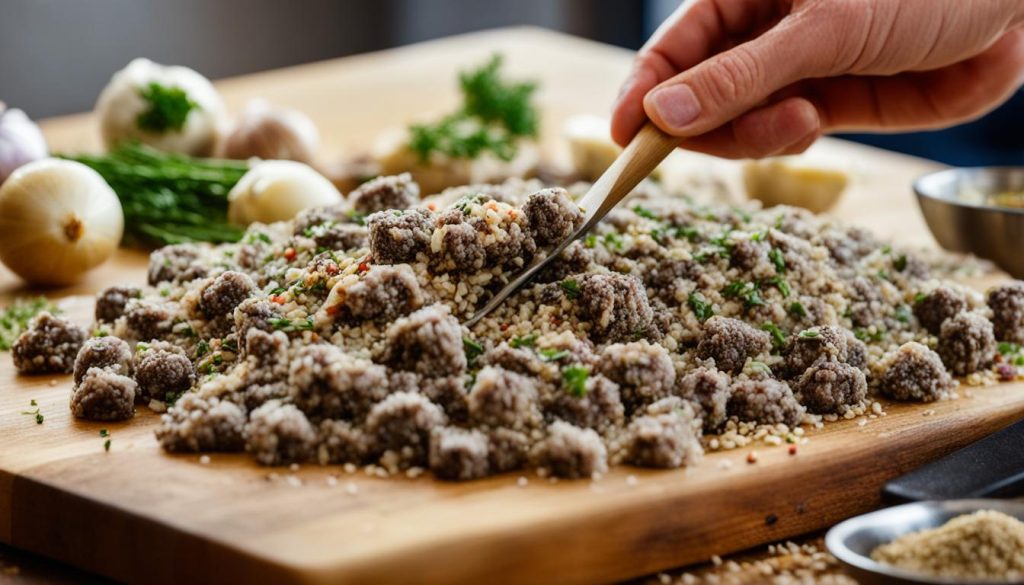
Crafting an authentic Scottish haggis from scratch is a time-honoured tradition that rewards those who take the time to follow the recipe closely. Let’s dive into the step-by-step instructions to create this beloved national dish.
Step-by-Step Instructions
1. Thoroughly clean and trim the lamb pluck.

2. Simmer the lamb pluck in water for around 2 hours until tender. Once cooked, dice or grate the pluck and set aside.
3. In a large mixing bowl, combine the diced/grated lamb pluck with coarse oatmeal, suet, chopped onions, black pepper, ground coriander, and mace. Mix well to create the haggis filling.
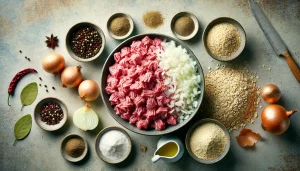
4. Stuff the haggis filling into the prepared ox bung casing or pudding basin, leaving room for expansion during cooking.
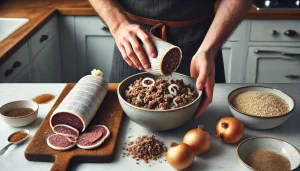
5. Securely tie off the casing at both ends to prevent spills.
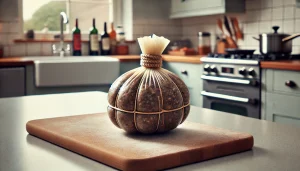
6. Place the filled haggis in a large pot and cover with simmering water.
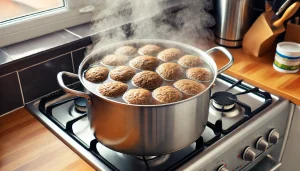
7. Cook for 1.5 to 2 hours, maintaining a gentle simmer and turning the haggis occasionally.
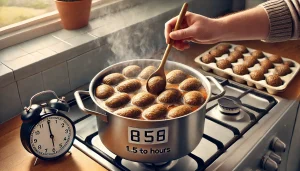
8. Ensure the haggis reaches an internal temperature of at least 74°C.
9. Once cooked, carefully remove the haggis from the pot.
10. Slice and serve the haggis alongside neeps (mashed swede) and tatties (mashed potatoes) for a traditional Scottish feast.

Cooking Times and Temperatures
The key to perfectly cooked haggis is to simmer it for 1.5 to 2 hours, ensuring it reaches a minimum internal temperature of 74°C. This lengthy cooking time allows the flavours to meld and the oatmeal to fully absorb the rich, savoury juices of the lamb offal.
If the haggis casing happens to split during cooking, carefully remove the haggis, rewrap it in a new casing or pudding basin, and continue simmering until fully cooked through. Maintaining the proper cooking times and temperatures is essential for achieving an authentic, delicious Scottish haggis.
Serving Suggestions
When it comes to serving haggis, the traditional Scottish accompaniments are a must-try. Neeps (mashed swede) and tatties (mashed potatoes) are the quintessential pairing, often referred to as the ‘holy trinity’ of a Burns Night celebration. The earthy, savoury flavours of the haggis complement the sweetness of the neeps and the starchiness of the tatties perfectly, creating a harmonious balance of tastes and textures.
Whisky Pairing
A dram of Scottish whisky is also a popular addition to a haggis-centric meal. The warmth and subtle smokiness of the spirit can enhance the richness of the haggis, providing a delightful contrast. When selecting a whisky to pair with your homemade haggis, consider traditional Highland or Speyside expressions that offer a smooth, well-rounded profile to complement the dish.
Variations and Tips
While the traditional recipe for Scottish haggis relies on lamb offal, the article will also explore vegetarian and vegan alternatives that capture the essence of the dish. These include substituting the meat components with plant-based proteins and textures, creating delectable vegetarian haggis and vegan haggis options.
Cooking Haggis in a Pudding Basin
In addition to the traditional ox bung casing, the article will cover techniques for cooking haggis in a pudding basin. This method provides a more convenient and accessible option for home cooks, allowing them to enjoy the rich, savoury flavours of haggis pudding basin without the hassle of sourcing the traditional casing.
Frying Cooked Haggis
The article will also explore methods for frying slices of cooked haggis to add extra flavour and caramelisation. This technique of frying cooked haggis offers a delicious alternative to the classic boiled or steamed preparation, adding a crisp, golden-brown exterior that complements the soft, succulent interior of the haggis.
These variations provide more flexibility for home cooks and offer additional ways to enjoy this iconic Scottish delicacy, whether opting for plant-based alternatives, experimenting with different cooking methods, or seeking creative new ways to elevate the traditional haggis experience.
Conclusion
In conclusion, this article has provided a comprehensive guide to making authentic Scottish haggis, exploring the history, ingredients, and preparation methods of this iconic national dish. From the traditional recipe using lamb offal, oatmeal and spices, to vegetarian and vegan alternatives, as well as techniques for cooking haggis in a pudding basin or frying the cooked pudding, the article has covered all the essential aspects of creating a delicious homemade haggis.
Whether served as part of a Burns Night celebration or enjoyed year-round, haggis remains a beloved and integral part of Scottish culinary heritage. Its distinct flavour and texture have made it a staple of traditional Scottish cuisine, and this guide has aimed to equip readers with the knowledge and skills to recreate this iconic dish in their own kitchens.
From the carefully selected lamb offal and oatmeal stuffing to the perfect pairing with neeps and tatties, every element of the haggis-making process has been explored in detail. Whether one chooses to follow the traditional recipe or experiment with vegetarian or vegan variations, the end result is a celebration of Scotland’s rich cultural heritage and a delicious addition to any Burns Night supper or year-round feast.
FAQ
What is haggis?
Haggis is a traditional Scottish savoury pudding made from a combination of lamb offal (heart, lungs and liver), oatmeal, onions and a blend of spices, typically encased in a sheep’s stomach or synthetic casing. It is considered the national dish of Scotland and has a long and storied history.
What are the key ingredients in traditional Scottish haggis?
The key ingredients in traditional Scottish haggis are the lamb pluck (heart, lungs and liver), coarse oatmeal or pinhead oats, an ox bung casing, and a blend of spices and seasonings such as black pepper, coriander and mace.
How is haggis made?
Making haggis from scratch involves several key steps, including thoroughly cleaning and cooking the lamb pluck, dicing or grating the cooked meat, and mixing it with the coarse oatmeal, suet, spices and seasonings to create the haggis filling. The mixture is then stuffed into the prepared ox bung casing, or a pudding basin if using that method, and simmered for 1.5-2 hours to fully cook through.
What are the traditional accompaniments to haggis?
Haggis is traditionally served with two classic Scottish accompaniments – neeps (mashed swede) and tatties (mashed potatoes), often referred to as ‘the holy trinity’ of Burns Night fare. A dram of Scottish whisky is also a popular addition to the meal.
Are there any vegetarian or vegan alternatives to traditional haggis?
Yes, the article explores vegetarian and vegan alternatives to the traditional haggis recipe, which substitute the meat components with plant-based proteins and textures to capture the essence of the dish.
Can haggis be cooked in a pudding basin instead of the traditional ox bung casing?
Yes, the article covers techniques for cooking haggis in a pudding basin instead of the traditional ox bung casing, as well as methods for frying slices of cooked haggis to add extra flavour and caramelisation.

Haggis Recipe
Ingredients
- 1 lamb pluck heart, lungs, and liver
- 200 g coarse oatmeal
- 100 g suet
- 1 large onion finely chopped
- 1 tsp black pepper
- 1 tsp ground coriander
- 1/2 tsp mace
Instructions
- Thoroughly clean and trim the lamb pluck.
- Simmer the lamb pluck in water for around 2 hours until tender. Once cooked, dice or grate the pluck and set aside.
- In a large mixing bowl, combine the diced/grated lamb pluck with coarse oatmeal, suet, chopped onions, black pepper, ground coriander, and mace. Mix well to create the haggis filling.
- Stuff the haggis filling into the prepared ox bung casing or pudding basin, leaving room for expansion during cooking.
- Securely tie off the casing at both ends to prevent spills.
- Place the filled haggis in a large pot and cover with simmering water.
- Cook for 1.5 to 2 hours, maintaining a gentle simmer and turning the haggis occasionally.
- Ensure the haggis reaches an internal temperature of at least 74°C.
- Once cooked, carefully remove the haggis from the pot.
- Slice and serve the haggis alongside neeps (mashed swede) and tatties (mashed potatoes) for a traditional Scottish feast.


